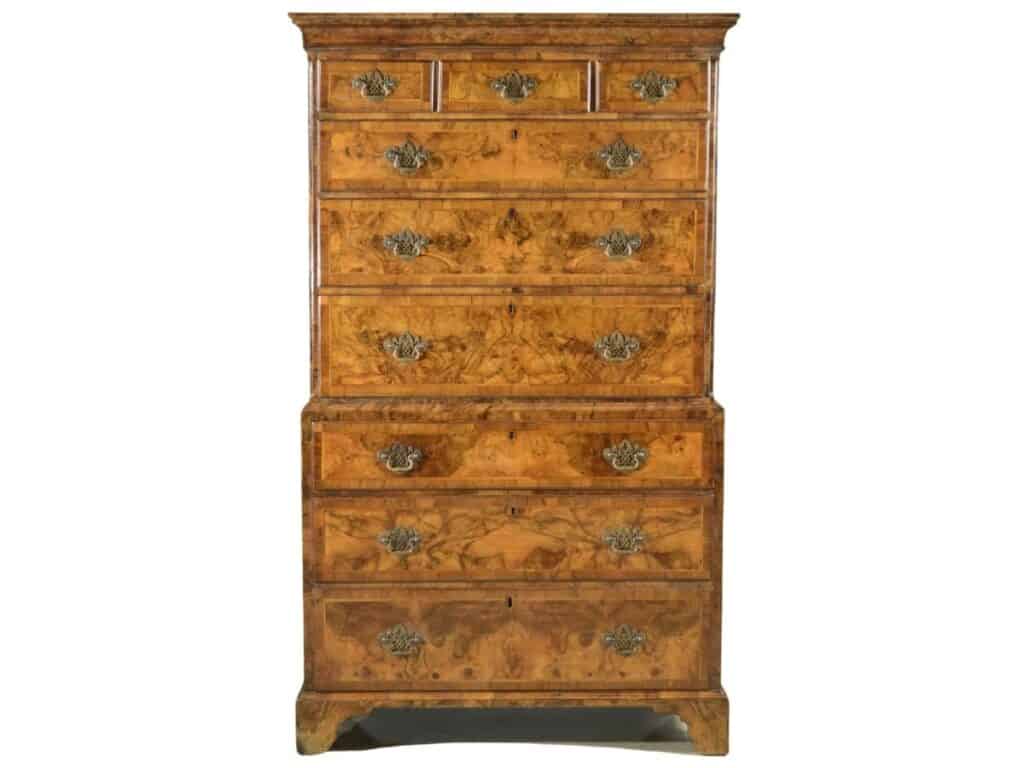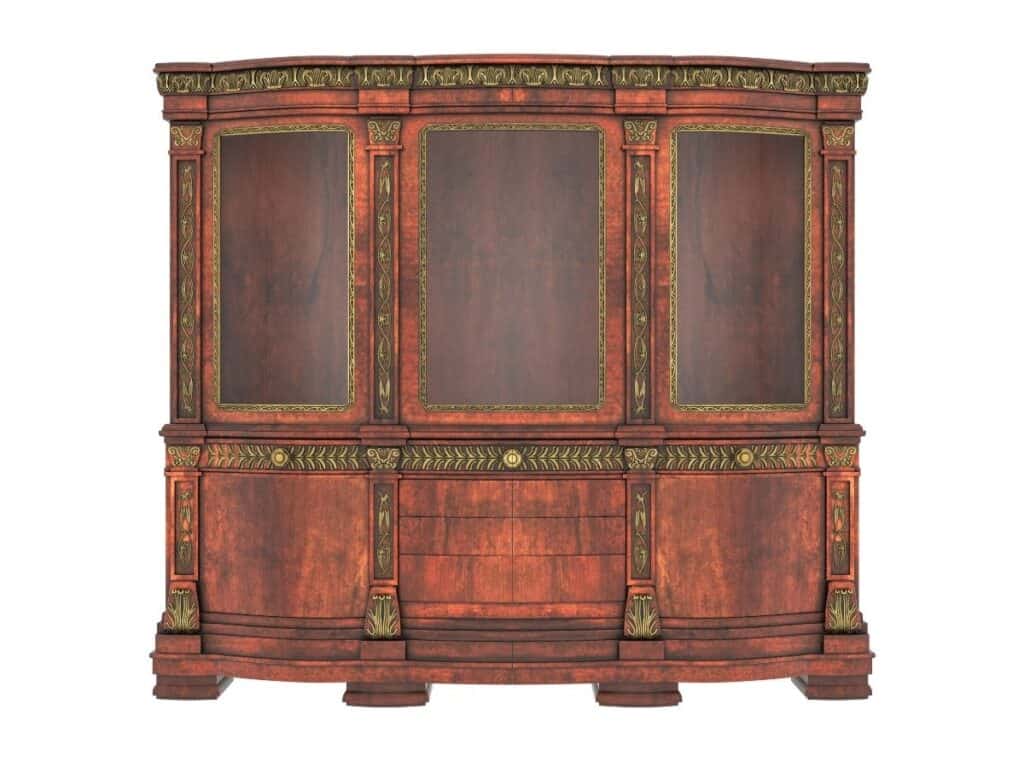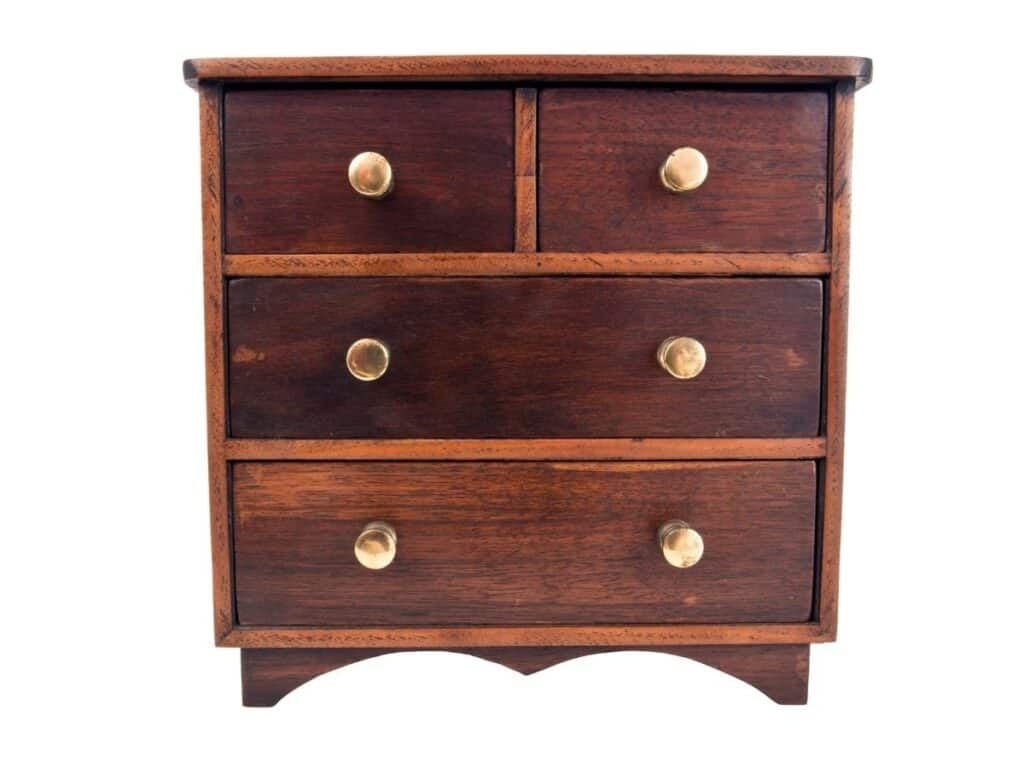Dressers are an essential storage element in any bedroom or hallway. However, when you are looking for a new dresser, it can be hard to figure out the best type. There are three main dresser types: highboy, tallboy, and lowboy. Each dresser type has its unique qualities and benefits that set them apart from one another, rendering one the optimal choice depending on your needs.
Highboys, tallboys, lowboys differ mostly in size, cost, and design. A highboy and a tallboy are similar in size but differ in design. A tallboy consists of a wardrobe on top of a chest of drawers versus a highboy with two chests of drawers. Lowboys are a smaller alternative built solely with drawers. Due to their differences, each has pros and cons to consider.
We understand this is many factors you have to take into account before you can choose between these common dresser types. Therefore, we’ve dedicated this article to comparing highboy, tallboy, lowboy dressers based on their most influential similarities and difference to help make the decision easier. By the end of this read, we guarantee you’ll be confident in which dresser is best for you.
Are Highboy and Tallboy Dressers the Same Thing?
Before we get too far into the comparison between all three dresser types, we’d like to start by clearing up a common misconception about highboy and tallboy dressers. Many people think these dresser types are synonymous and, therefore, the same thing. We’re here to tell you that isn’t the case.
Although highboy and tallboy dressers have a number of similarities, particularly in size and some of their design elements, they are two different types of dressers. The overarching difference is the dresser’s top layer, consisting of an additional chest of drawers on a highboy and a wardrobe on a tallboy.
The root cause of this misconception is that tallboys were based on highboys with a few design modifications.
Historically, highboys were created first and became popular in England 1600s, starting with the simple William and Mary style before progressing into the baroque style Queen Anne style in the 18th century, and finally, the vastly ornate early Georgian style.
While the highboys were all the rage in English décor and storage, Americans opted to call them tallboys instead and made their version of the English dresser with a few modifications.
While it wasn’t uncommon for Americans to refer to English highboys as tallboys in the 17th and 18th centuries, the two dressers are technically different. However, this explains where a great deal of the confusion originates in whether or not highboys and tallboys are the same.
The Modern Tallboy
Another source of confusion for the highboy versus tallboy debate is that there has been a significant rise in a new design for the tallboy, referred to as the modern tallboy.
If you placed an 18th-century tallboy next to its modern counterpart, you’d think they were two different dressers, and in a way, they are. Rather than featuring the classic tallboy’s quintessential wardrobe compartment, the modern tallboy is merely a small chest of drawers more similar to a highboy but on a greatly reduced scale.
Usually, these dressers have about five to six drawers stacked in a vertical pillar and measure around 45-50 inches tall and 29-22 inches wide. These dressers can be found scattered throughout the house, storing clothing, dining room cutlery, linens, and tablecloths, or various other small objects you want to neatly tuck away.
So, if this is the dresser you had in mind when you read “tallboy,” know that there is a slimmer, modern option out there, but this isn’t the type of dresser we’re referring to.
Highboy, Tallboy, Lowboy Dresser Comparison
If you’re on the hunt for a new dresser, the last thing you want to do is waste time agonizing over which dresser type to pick because you don’t know the differences between them. Here, we’ll detail everything you need to know about highboy, tallboy, and lowboy dressers by comparing each option in terms of design, purpose, cost, and size.
For a quick overview, highboys and tallboys are usually around the same cost and height of 65-80 inches but differ in their top half designs, as we’ve mentioned previously. Additionally, tallboys are often slimmer than highboys due to their differing storage purposes. Lowboys are the cheaper and smaller dresser option that more closely resembles a dressing table or console.
While this is enough to maybe help you decide whether you want a lowboy versus the larger alternatives, it might not be everything you need to choose between a tallboy and a highboy. Therefore, we urge you to read on for our in-depth comparison below.
Design Comparison
Design is undoubtedly the most influential difference between these dresser types and will help you more easily determine which matches your needs best.
Highboys
As we stated previously, highboys are designed to be extremely tall dressers built in two parts. On the bottom of the dresser is a wide chest of usually one to three drawers.

On top of this chest of drawers is another slightly slimmer chest of drawers that can range anywhere from three to eight in number. The ones with more drawers will typically split the top row into two or three smaller drawers for more storage possibilities.
Due to their purpose, which we’ll discuss more momentarily, many highboys will be built out of high-quality woods and decorated ornately, making many pricier than tallboys who tend to be slightly less ornate. This also renders older highboys to be valuable antiques many individuals avidly pursue.
Tallboys
Like the highboy, tallboy dressers are another example of exceptionally tall dressers that consist of two parts. On the bottom, they follow suit behind the highboy’s design and boast a wide chest of drawers ranging from one to three in number. However, the glaring difference is the top component.

A tallboy is equipped with a wardrobe compartment above the bottom chest of drawers rather than another chest of drawers like the highboy. The wardrobe will match the chest of drawers in width for a uniform look versus the highboy, which typically has a slimmer chest of drawers on top.
There are some variations with the tallboy’s design depending on the wardrobe’s size. For example, some tallboys will only have a wardrobe on top of the chest of drawers you can access through a double-door design.
Alternatively, some tallboys will split the top component and have a single-doored wardrobe on one side and a number of drawers on the other. This is undoubtedly the most versatile storage option of the three dresser types.
Lowboys
Not to be completely outdone by the tallboy and highboy dressers, the lowboy is a perfectly legitimate storage option on a much smaller scale. In terms of design, these dressers are much smaller, measuring maybe one-third to one-fourth of a tallboy or highboy’s height, and so, it is built with a series of smaller drawers.
I have in fact made an entire course on how to organize your lowboy dresser to fit all your clothes in one.

On average, a lowboy boasts anywhere from three to six drawers, but it isn’t uncommon to see particularly wide lowboys with ten or more drawers. Because of their reduced height, you have a little more width versatility with lowboys than the other dresser options.
Ornate design with lowboys really depends on which one you buy (which is arguably the case with highboys and lowboys as well).
Since this dresser type can be placed in a wide range of locations throughout the home, you’ll find some that are incredibly ornate and some that are quite plain, versus highboys that are frequently ornately decorated and tallboys that tend to be a bit simpler.
Learn about bureau closets here.
Purpose Comparison
The purpose of these dressers has a significant effect on their level of ornateness and will help you decide quicker between the three. When considering which dresser type you want, we highly suggest detailing your intentions for the dresser first and then comparing these with the information below so you can pick the most appropriate option.
Highboys
Because of their rows upon rows of drawers, highboys are commonly used in spaces where you need as much storage as possible. Some individuals prefer to use smaller highboys for linen storage if they don’t have a linen closet, but their most frequent location in the home is the dining room.

You can buy this highboy dresser on Amazon (paid link).
Highboys are commonly used to store fine china and other delicate and valuable items, which tend to be stored in the dining room where more upscale and formal events are held. As a result, many are decorated ornately with the finest wood, extravagantly sculpted brass handles, and intricate carvings to match the room’s aesthetic and stand out as a staple piece to be admired.
Of course, some individuals who prefer to have as much dresser storage as possible will purchase a highboys dresser for their bedrooms. These tend to be simpler in design since they’re primarily chosen for functionality rather than appearance.
Tallboys
The wardrobe in tallboys changes its purpose entirely from a simple chest upon chest of drawers to a dresser entirely dedicated to clothes. In the case of a highboy, owners have the option of storing virtually anything inside the countless drawers, but you’d be hard-pressed to find objects you can store in a tallboy’s wardrobe other than hanging clothing items.

You can buy this tallboy-like dresser on Amazon (paid link).
Because the tallboy dresser is usually dedicated to clothing storage, you’ll most frequently find them in bedrooms. On occasion, owners will purchase them to place in their foyers or mudrooms as well to hang jackets and conveniently store items you’ll use as you enter and exit the home.
As you might have guessed, tallboys residing in more low-traffic or informal spaces means they have a more minimal décor than their fancier alternative, the highboy.
Lowboys
While the tallboy is the most versatile dresser in terms of its storage abilities, the lowboy is the most versatile in its purposes and where you would ordinarily find them in the home.

You can buy this lowboy dresser on Amazon (paid link).
Originally, lowboys were used as dressing tables or vanities in people’s bedrooms to hold common items such as makeup jewelry, hair accessories, or even toiletries. While this is still a common use for lowboys today, in addition to being bedside tables, they’re no longer found solely in the bedroom or bathroom.
Does a dresser really need a mirror? Tap to learn more.
Nowadays, people will use lowboys as entryway tables in their foyers, a small chest of drawers in their dining rooms, or basic storage in family and living rooms. Because the width of these dressers can vary significantly, this also alters where you can place them and what items you can store within.
Size and Cost Comparison
We’ve alluded to the differences in size and cost for tallboys, highboys, and lowboys previously throughout this article, but we’ll reiterate it more clearly here.
Highboys and tallboys tend to be pricier and about the same size in terms of height, reaching an average of 65-80 inches tall. In terms of width, a highboy is usually wider at 36-45 inches versus the tallboy’s average width of 18-35 inches. Comparatively, the cheaper lowboys aren’t usually taller than waist height (28-38 inches), and their widths can vary greatly 25-65+ inches.
While we’d like to give you a hard number for the average cost of each, the figure varies significantly by dresser. For the most part, lowboys will always be cheaper than highboys or tallboys, but a majority of the cost depends on size, design (number of drawers and ornateness), and age of each dresser.
Because highboys tend to be more ornate, they are often pricier than tallboys, but this isn’t always the case. Size, on the other hand, is usually consistent, with the highboy being wider than tallboys and the lowboys being significantly shorter.
This is important to know in relation to the space you are trying to fill and the purpose of your dresser. For instance, you might have a hard time fitting a wide highboy in your bedroom versus a slimmer tallboy, and if the goal is just to store clothes, the tallboy would be a better choice regardless.
Final Thoughts
Hopefully, with our comparison coming to a close, you’re more confident in your abilities to discern a highboy, tallboy, and lowboy dresser from one another. Of course, now comes to the burning question of which is best for you? While you can’t really go wrong with any of these dresser types, we recommend you base your decision on what you intend to store and the size of your space.
Smaller spaces should be matched with a tallboy or small lowboy, whereas larger spaces can be filled with a highboy or long lowboy. The choice of which matches your space, needs, and even aesthetic is ultimately up to you.
Next, you can learn what to look for in a quality dresser.

I’m an expert wardrobe organizer and a bit of a clean freak. I created this website and its YouTube channel to share practical guides about laundry and organizing. My teachings have been featured in multiple large news publications, and I’ve self-published two wardrobe organizing books and an entire course on the subject.

